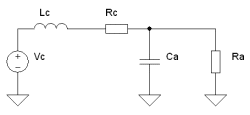yeah. haha. thanks for the research sir Jojo. I was actually relieved that the problem was solved by changing ICs since I do not really know much about electronics. i'm just a fan of good music.
On the contrary sir, there was not supposed to be a problem that needed solving in the first place. But as the title of the thread says, ICs matter, especially how and what they are made of.

Using A and B produced static because they were not able to fulfill the need of the TT > Phono Preamp transmission line specification. The sad part for most people who don't know about electronics will be to dispense A and B as inferior than C and D. Kudos to you for you did not.

Anyway, this can get a little bit techie but this is where the fun starts, or sometimes headaches.


Consider the image above where the signal from the cart is represented by a voltage source (Vc) and and inductor and resistor Lc and Rc. Another source of resistance would be the interconnect but since it would only account for a meter or so then it is dispensed as 0 already. The load resistance and interconnect ideal impedance is lumped as Ra.
Now, notice Ca, it is in fact the sum of the capacitance of the interconnect and the input capacitance of the phono preamp. For most electronics buffs, they will say that Rc and Ca actually forms a low pass filter, quite correct indeed but not noticing the effects of Lc is where they fail! These conditions actually forms an LC resonant tank and from the word resonant, it means something resonates... and we don't want something in front of a +40dB phono preamp resonating don't we?
